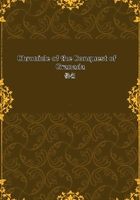
第89章
The king now came forth in royal state, mounted on a superb chestnut horse and attended by many grandees of Castile. He wore a jubon or close vest of crimson cloth, with cuisses or short skirts of yellow satin, a loose cassock of brocade, a rich Moorish scimetar, and a hat with plumes. The grandees who attended him were arrayed with wonderful magnificence, each according to his taste and invention.
These high and mighty princes (says Antonio Agapida) regarded each other with great deference as allied sovereigns, rather than with connubial familiarity as mere husband and wife. When they approached each other, therefore, before embracing, they made three profound reverences, the queen taking off her hat and remaining in a silk net or caul, with her face uncovered. The king then approached and embraced her, and kissed her respectfully on the cheek. He also embraced his daughter the princess, and, making the sign of the cross, he blessed her and kissed her on the lips.*
*Cura de los Palacios.
The good Agapida seems scarcely to have been more struck with the appearance of the sovereigns than with that of the English earl.
He followed (says he) immediately after the king, with great pomp and, in an extraordinary manner, taking precedence of all the rest.
He was mounted "a la guisa," or with long stirrups, on a superb chestnut horse, with trappings of azure silk which reached to the ground. The housings were of mulberry powdered with stars of gold.
He was armed in proof, and wore over his armor a short French mantle of black brocade; he had a white French hat with plumes, and carried on his left arm a small round buckler banded with gold. Five pages attended him, apparelled in silk and brocade and mounted on horses sumptuously caparisoned; he had also a train of followers bravely attired after the fashion of his country.
He advanced in a chivalrous and courteous manner, making his reverences first to the queen and infanta, and afterward to the king. Queen Isabella received him graciously, complimenting him on his courageous conduct at Loxa, and condoling with him on the loss of his teeth. The earl, however, made light of his disfiguring wound, saying that "our Blessed Lord, who had built all that house, had opened a window there, that he might see more readily what passed within;"* whereupon the worthy Fray Antonio Agapida is more than ever astonished at the pregnant wit of this island cavalier.
The earl continued some little distance by the side of the royal family, complimenting them all with courteous speeches, his horse curveting and caracoling, but being managed with great grace and dexterity, leaving the grandees and the people at large not more filled with admiration at the strangeness and magnificence of his state than at the excellence of his horsemanship.**
*Pietro Martyr, Epist. 61.
**Cura de los Palacios.
To testify her sense of the gallantry and services of this noble English knight, who had come from so far to assist in their wars, the queen sent him the next day presents of twelve horses, with stately tents, fine linen, two beds with coverings of gold brocade, and many other articles of great value.
Having refreshed himself, as it were, with the description of this progress of Queen Isabella to the camp and the glorious pomp of the Catholic sovereigns, the worthy Antonio Agapida returns with renewed relish to his pious work of discomfiting the Moors.
The description of this royal pageant and the particulars concerning the English earl, thus given from the manuscript of Fray Antonio Agapida, agree precisely with the chronicle of Andres Bernaldez, the curate of Los Palacios. The English earl makes no further figure in this war. It appears from various histories that he returned in the course of the year to England. In the following year his passion for fighting took him to the Continent, at the head of four hundred adventurers, in aid of Francis, duke of Brittany, against Louis XI. of France. He was killed in the same year (1488) in the battle of St. Alban's between the Bretons and the French.